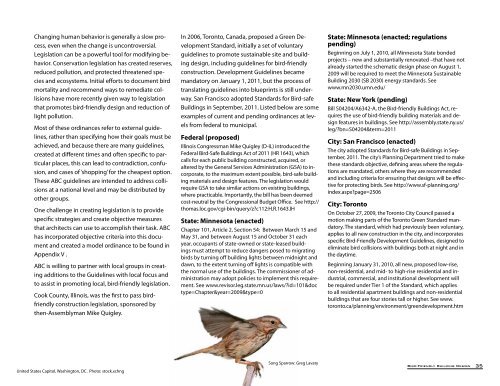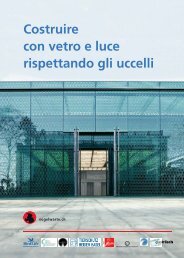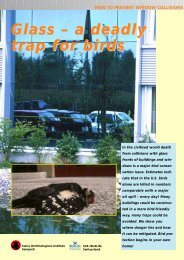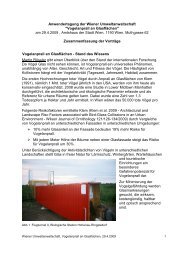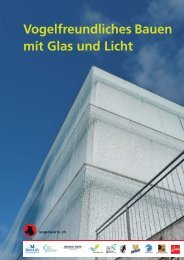Bird-Friendly Building Design Bird-Friendly ... - Lights Out Indy
Bird-Friendly Building Design Bird-Friendly ... - Lights Out Indy
Bird-Friendly Building Design Bird-Friendly ... - Lights Out Indy
Create successful ePaper yourself
Turn your PDF publications into a flip-book with our unique Google optimized e-Paper software.
Changing human behavior is generally a slow process,even when the change is uncontroversial.Legislation can be a powerful tool for modifying behavior.Conservation legislation has created reserves,reduced pollution, and protected threatened speciesand ecosystems. Initial efforts to document birdmortality and recommend ways to remediate collisionshave more recently given way to legislationthat promotes bird-friendly design and reduction oflight pollution.Most of these ordinances refer to external guidelines,rather than specifying how their goals must beachieved, and because there are many guidelines,created at different times and often specific to particularplaces, this can lead to contradiction, confusion,and cases of ‘shopping’ for the cheapest option.These ABC guidelines are intended to address collisionsat a national level and may be distributed byother groups.One challenge in creating legislation is to providespecific strategies and create objective measuresthat architects can use to accomplish their task. ABChas incorporated objective criteria into this documentand created a model ordinance to be found inAppendix V .ABC is willing to partner with local groups in creatingadditions to the Guidelines with local focus andto assist in promoting local, bird-friendly legislation.Cook County, Illinois, was the first to pass birdfriendlyconstruction legislation, sponsored bythen-Assemblyman Mike Quigley.In 2006, Toronto, Canada, proposed a Green DevelopmentStandard, initially a set of voluntaryguidelines to promote sustainable site and buildingdesign, including guidelines for bird-friendlyconstruction. Development Guidelines becamemandatory on January 1, 2011, but the process oftranslating guidelines into blueprints is still underway.San Francisco adopted Standards for <strong>Bird</strong>-safe<strong>Building</strong>s in September, 2011. Listed below are someexamples of current and pending ordinances at levelsfrom federal to municipal.Federal (proposed)Illinois Congressman Mike Quigley (D-IL) introduced theFederal <strong>Bird</strong>-Safe <strong>Building</strong>s Act of 2011 (HR 1643), whichcalls for each public building constructed, acquired, oraltered by the General Services Administration (GSA) to incorporate,to the maximum extent possible, bird-safe buildingmaterials and design features. The legislation wouldrequire GSA to take similar actions on existing buildings,where practicable. Importantly, the bill has been deemedcost-neutral by the Congressional Budget Office. See http://thomas.loc.gov/cgi-bin/query/z?c112:H.R.1643.IHState: Minnesota (enacted)Chapter 101, Article 2, Section 54: Between March 15 andMay 31, and between August 15 and October 31 eachyear, occupants of state-owned or state-leased buildingsmust attempt to reduce dangers posed to migratingbirds by turning off building lights between midnight anddawn, to the extent turning off lights is compatible withthe normal use of the buildings. The commissioner of administrationmay adopt policies to implement this requirement.See www.revisor.leg.state.mn.us/laws/?id=101&doctype=Chapter&year=2009&type=0State: Minnesota (enacted; regulationspending)Beginning on July 1, 2010, all Minnesota State bondedprojects – new and substantially renovated –that have notalready started the schematic design phase on August 1,2009 will be required to meet the Minnesota Sustainable<strong>Building</strong> 2030 (SB 2030) energy standards. Seewww.mn2030.umn.edu/State: New York (pending)Bill S04204/A6342-A, the <strong>Bird</strong>-friendly <strong>Building</strong>s Act, requiresthe use of bird-friendly building materials and designfeatures in buildings. See http://assembly.state.ny.us/leg/?bn=S04204&term=2011City: San Francisco (enacted)The city adopted Standards for <strong>Bird</strong>-safe <strong>Building</strong>s in September,2011. The city’s Planning Department tried to makethese standards objective, defining areas where the regulationsare mandated, others where they are recommendedand including criteria for ensuring that designs will be effectivefor protecting birds. See http://www.sf-planning.org/index.aspx?page=2506City: TorontoOn October 27, 2009, the Toronto City Council passed amotion making parts of the Toronto Green Standard mandatory.The standard, which had previously been voluntary,applies to all new construction in the city, and incorporatesspecific <strong>Bird</strong>-<strong>Friendly</strong> Development Guidelines, designed toeliminate bird collisions with buildings both at night and inthe daytime.Beginning January 31, 2010, all new, proposed low-rise,non-residential, and mid- to high-rise residential and industrial,commercial, and institutional development willbe required under Tier 1 of the Standard, which appliesto all residential apartment buildings and non-residentialbuildings that are four stories tall or higher. See www.toronto.ca/planning/environment/greendevelopment.htmUnited States Capitol, Washington, DC . Photo: stock.xchngSong Sparrow: Greg Lavaty<strong>Bird</strong>-<strong>Friendly</strong> <strong>Building</strong> <strong>Design</strong>35


